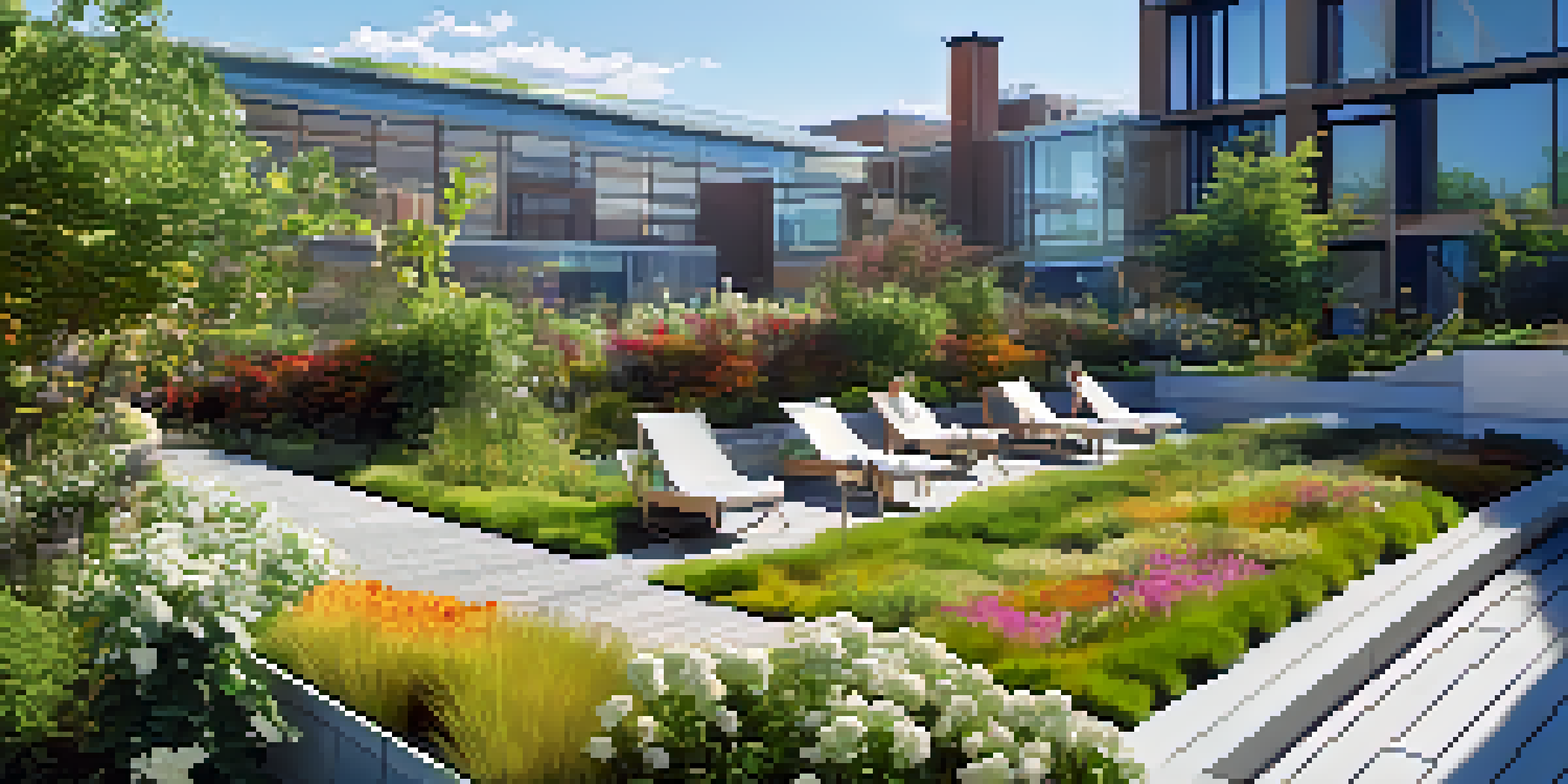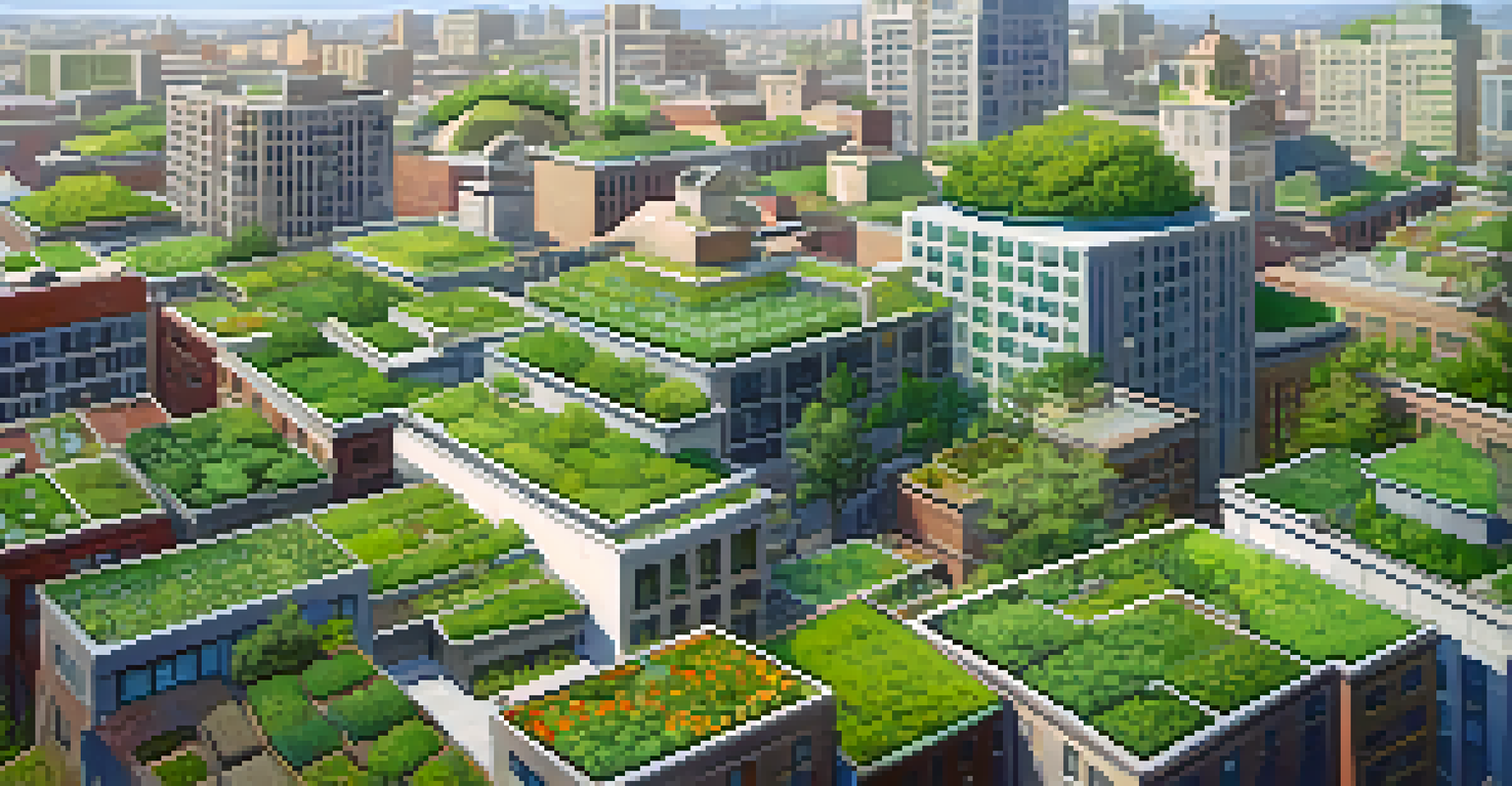Adopting Green Roof Technology for Urban Sustainability

What Are Green Roofs and Their Importance?
Green roofs are essentially layers of vegetation planted on rooftops. They not only beautify urban landscapes but also play a crucial role in environmental sustainability. By absorbing rainwater and providing insulation, these roofs help reduce the urban heat island effect, which is a common issue in densely populated areas.
The greatest threat to our planet is the belief that someone else will save it.
Moreover, they improve air quality by filtering pollutants and producing oxygen. Think of green roofs as a small forest in the sky, working tirelessly to enhance the ecosystem around them. This transformation of unused rooftop space into a green sanctuary can significantly impact urban biodiversity.
Incorporating green roofs into city planning isn't just a trend; it's a necessary step towards sustainable urban living. As more cities face challenges like climate change and population growth, the adoption of green roofs offers a viable solution to mitigate these issues.
Key Benefits of Green Roofs for Cities
One of the standout benefits of green roofs is their ability to manage stormwater. By absorbing rainfall, they reduce the amount of water that flows into storm drains, which can help mitigate flooding during heavy rains. This feature can be particularly beneficial in urban areas where pavement dominates the landscape.

Additionally, green roofs can significantly lower energy costs. They provide natural insulation, which helps keep buildings cooler in the summer and warmer in the winter. This efficiency not only saves money but also reduces the overall energy demand on the grid, promoting a more sustainable energy future.
Green Roofs Enhance Urban Sustainability
Green roofs absorb rainwater, improve air quality, and reduce energy costs, making them vital for sustainable urban living.
Finally, green roofs create recreational spaces for city dwellers. They offer a peaceful retreat amidst the hustle and bustle of urban life, allowing residents to connect with nature. Imagine stepping onto your rooftop garden, surrounded by greenery, and feeling a sense of calm in an otherwise busy environment.
Challenges in Implementing Green Roofs
Despite their numerous benefits, implementing green roofs can come with challenges. One of the primary hurdles is the initial cost associated with installation. While long-term savings are substantial, the upfront investment can deter building owners and developers from making the switch.
In every walk with nature one receives far more than he seeks.
Another challenge is the complexity of construction and maintenance. Green roofs require specific engineering to ensure proper drainage and weight distribution. This complexity can lead to increased labor costs and necessitate specialized knowledge, making it essential for property owners to work with experienced professionals.
Lastly, climate considerations play a role in the feasibility of green roofs. Certain plant species thrive better in specific environments, so it's crucial to choose vegetation that can withstand local weather conditions. This necessitates thoughtful planning and research to ensure successful growth.
Types of Green Roof Systems
There are two main types of green roof systems: extensive and intensive. Extensive green roofs are lighter and require minimal maintenance, making them an excellent choice for residential buildings. They typically support low-growing plants and are designed to be self-sustaining.
In contrast, intensive green roofs are deeper and can support a wider variety of plants, including shrubs and small trees. These roofs often require more maintenance and irrigation, but they provide greater biodiversity and recreational opportunities. Picture a lush urban park right on top of a building!
Challenges in Green Roof Adoption
Initial installation costs and the complexity of construction can deter property owners from implementing green roofs.
Understanding these two systems is essential for property owners looking to adopt green roof technology. Each type has its unique advantages and challenges, so selecting the right system aligns with both the building's purpose and the owner's commitment to sustainability.
Successful Examples of Green Roofs Worldwide
Cities around the world are leading the way in green roof implementation. For instance, the city of Toronto boasts over 1,000 green roofs, showcasing their commitment to sustainability. These roofs not only enhance the city's aesthetics but also contribute to biodiversity and improved air quality.
Another notable example is the Bosco Verticale in Milan, Italy, which features residential towers adorned with thousands of trees and plants. This innovative design not only provides stunning views but also helps combat air pollution in the city. It’s a prime example of how green roofs can be integrated into modern architecture.
These successful initiatives serve as a source of inspiration for other cities aiming to become more sustainable. By showcasing the effectiveness and beauty of green roofs, urban planners can encourage similar projects in their communities.
The Role of Policy in Promoting Green Roofs
Government policies play a crucial role in promoting green roofs. Many cities have begun to introduce incentives such as tax breaks or grants for building owners who incorporate green roofs into their designs. These incentives can significantly offset installation costs, making green roofs more accessible.
In some areas, municipalities have even mandated green roofs for new commercial buildings. This proactive approach not only encourages sustainable practices but also sets a precedent for future developments. It's a win-win for both the environment and the community.
Government Policies Support Green Roofs
Incentives and mandates from governments can promote the adoption of green roofs, making them more accessible and beneficial for communities.
Moreover, public awareness campaigns can help educate residents and developers about the benefits of green roofs. By fostering a culture of sustainability, cities can drive demand for green roofs and inspire more property owners to take the plunge.
How to Get Started with Green Roofs
If you're considering a green roof for your building, start by assessing its structural capacity. Consulting with a structural engineer can help determine if your roof can support the additional weight of a green roof system. This step is crucial to avoid potential structural issues down the line.
Next, research local climate conditions and suitable plant species. Choosing the right plants ensures that your green roof thrives and requires minimal maintenance. Native plants are often the best choice, as they are adapted to local conditions and can attract beneficial wildlife.

Lastly, connect with experienced contractors who specialize in green roof installations. Their expertise will guide you through the process, from design to maintenance. With the right support, you'll be on your way to transforming your rooftop into a green oasis that benefits both you and the environment.